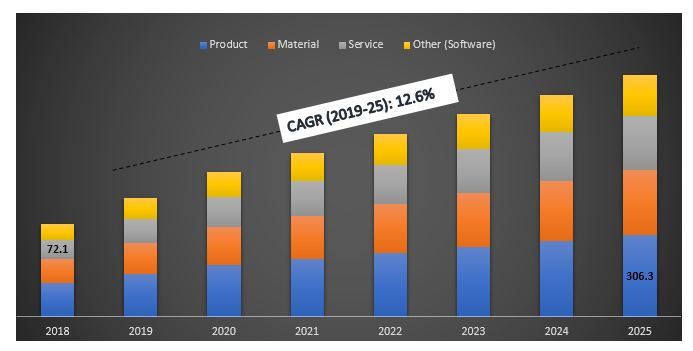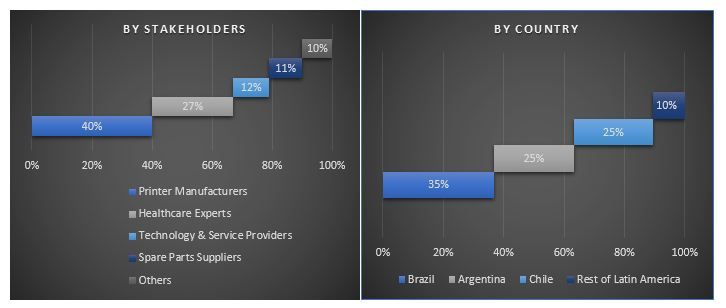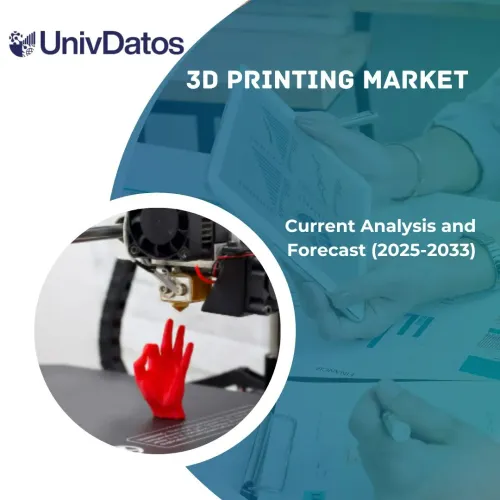- Home
- About Us
- Industry
- Services
- Reading
- Contact Us
Latin America Market Insights on 3D Printing: Insights & Forecasts, 2019-2025
Emphasis on Component ((Product (Professional/Industrial Printer, Personal/Desktop 3D Printers), Material (Polymer, Plastic, Metals and Alloys, Ceramic, Other Materials), Technology ( Stereolithography, Selective Laser Sintering, Electron Beam Melting, Fused Deposition Modelling, Laminated object Manufacturing, Other Technologies))
The Latin America 3D Printing Market stood at US$ 348.1 million in 2018 and is expected to grow at a CAGR of XX% sduring the forecast period 2019-2025. The market for additive manufacturing in Latin America has bolstered considerably majorly attributed to gradual expansion of 3D printing owing to surging investments by 3D market. With 3D printing becoming part of industrial production process, small chunk of 3D players has showcased their interest in the region and purposes to set up 3D shops and explore investment opportunities in South American marketplace. However, high cost involved in terms of 3D printers, political and economic crisis and skill shortage act impeding factors in the growth potential of Latin America 3D printing market. Rising need for skilled employees across the additive manufacturing industry has become one of the major concerns in the country while painful transitions from economic prosperity are hampering the prospects for 3D printing market in the country.
“The Product segment dominated the North America 3D printing market in 2018”
The report analyses 3D Printing market report majorly based on component, technology, applications and end users. Products, materials and services are the major components considered in the deep analysis of the 3D printing industry.
Latin America 3D Printing Market Size by Component, 2018-25 (US$ Mn)
“Fused Deposition Modelling dominated the technology segment of North America 3D Printing market in 2018”
Stereolithography, Selective Laser Sintering, Electron Beam Melting, Fused deposition modelling, Laminated object Manufacturing and Others are the major technologies considered while analysing the regional 3D printing market. Fused Deposition Modelling, Selective Laser Sintering and Stereolithography constitute as the topmost technologies in 3D printing. Fused Deposition Modelling occupied the prominent share in 2018 as it is one of the prominent and user-friendly technology that is widely used to create 3D printed objects.
“3D Printing is majorly applied for Functional parts manufacturing”
Based on application type, Latin America 3D printing market is bifurcated into functional parts, fit and assembly, prototype modelling, education, metal casting, Visual Aids, Presentation Modelling and other applications. Functional parts captured maximum share during 2018 owing to its fast speed, quality and low cost of additive manufacturing.
“Amongst End User, manufacturing industry held the maximum share in 2018 and is anticipated to maintain its dominance throughout the forecast period 2019-2025”
The major 3D printing end users covered in report are education, automotive, aerospace & defence, healthcare, consumer goods, manufacturing, construction and others. Manufacturing sector dominated 3D printing landscape during 2018 owing to bolstering digitalization wherein 3D printing solutions have paved way for manufacturing companies.
“Brazil dominates the Latin America 3D printing market and is expected to remain dominance throughout the forecast period”
The Latin America market is analysed based on its outreach in the countries such as Brazil, Argentina, Chile and rest of Latin America. Brazil captures the major share in Latin America 3D printing primarily owing to growing acceptance of the technique among various industry verticals such as automotive, aerospace and defence and other verticals.
Competitive Landscape-Top 10 Market Players
Key companies profiled in the report include 3D Systems Corporation, Arcam AB, Royal DSM N.V., Stratasys Ltd., Autodesk, Inc., The ExOne Company, Höganäs AB, Organovo Holdings, Inc, Mcor Technologies Limited and Voxeljet AG.
Reasons to buy (The research report presents):
- Current and future market size from 2018 to 2025 in terms of value (US$)
- Combined analysis of deep dive secondary research and input from primary research through Key Opinion Leaders of the industry
- Country level details of the overall market of 3D printing
- Country level details of the overall adoption of 3D printing technology
- A quick review of overall industry performance at a glance
- An In-depth analysis of key industry players
- A detailed analysis of regulatory framework, drivers, restraints, key trends and opportunities prevailing in the industry
- Examination of industry attractiveness with the help of Porter’s Five Forces analysis
- The study comprehensively covers the market across different segments and sub-segments of the 3D Printing global market
- Countries covered: Argentina, Brazil, Chile and Rest of Latin America
Customization Options:
The Latin America 3D Printing market can be customized for different region in Latin America region and at the country level as well. Besides this, UMI understands that you may have your own business need, hence we also provide fully customized solutions to clients.
Table of Content
Analysing historical market, estimation of the current market and forecasting the future market for Latin American 3D Printing market were the three major steps undertaken to create and analyse the overall adoption of 3D Printing in major Latin American countries. Exhaustive secondary research was conducted to collect the historical market of the product/technology and overall estimation of the current market. Secondly, to validate these insights, numerous findings and assumptions were taken into consideration. Moreover, exhaustive primary interviews were conducted with industry experts across value chain of the Latin American 3D printing market. After all assumption, market engineering and validation of market numbers through primary interviews, top-down approach was employed to forecast the market size of 3D Printing in the Latin American region to 2025. Thereafter, market breakdown and data triangulation methods were adopted to estimate and analyse the market size of segments and sub-segments of the market. Detailed research methodology is explained below:
Analysis of Historical Market Size
Step 1: In-Depth Study of Secondary Sources:
Detail secondary study was conducted to obtain the historical market size of the Latin America 3D Printing market through company internal sources such as annual report & financial statements of top players, performance presentations, press releases, sales figures etc. and external sources including journals, news & articles, government publications, competitor publications, sector reports, third-party database and other creditable publications.
Step 2: Market Segmentation:
After obtaining historical market size of the overall market, detailed secondary analysis was conducted to gather historical market insights and share for different segments & sub-segments for the Latin America 3D Printing market. Major segments included in the report are component, technology, application and end-user.
Step 3: Factor Analysis:
After acquiring the historical market size of different segments and sub-segments, detailed factor analysis was conducted to estimate the current market size of the Latin America 3D Printing market. Factor analysis was conducted using dependent and independent variable such as purchasing power, player initiatives, penetration of 3D printing, government regulations in major Latin American countries. Historical trends of the 3D Printing technology and their year-on-year impact on the market size and share in the recent past were analyzed. Demand and supply side scenario was also thoroughly studied.
Current Market Size Estimate & Forecast
Current Market Sizing: Based on actionable insights from the above 3 steps, we arrived at current market size, key players in market, market share of these players, industry’s supply chain, and value chain of the industry. All the required percentage shares, splits, and market breakdowns were determined using the above-mentioned secondary approach and were verified through primary interviews.
Estimation & Forecasting: For market estimation and forecast, weightage was assigned to different factors including drivers & trends, restraints, and opportunities available in the market. After analyzing these factors, relevant forecasting techniques i.e. Bottom-up/Top-down was applied to arrive at the market forecast pertaining to 2025 for different segment in major Latin American countries. The research methodology adopted to estimate the market size encompasses:
- The industry’s market size and rate of adoption of 3D Printing technology in Latin America in terms of value (US$)
- All percentage shares, splits, and breakdowns of market segments and sub-segments
- Key players across different technologies and markets as well as market share of each player. Also, the growth strategies adopted by these players to compete in the rapidly growing Latin American 3D Printing market
Market Size and Share Validation
Primary Research: In-depth interviews were conducted with the Key Opinion Leaders (KOLs) including Top Level Executives (CXO/VPs, Sales Head, Marketing Head, Operational Head, and Regional Head etc.). Primary research findings were summarized, and statistical analysis was performed to prove the stated hypothesis. Input from primary research were consolidated with secondary findings, hence turning information into actionable insights.
Split of Primary Participants
Market Engineering
Data triangulation technique was employed to complete the overall market engineering process and to arrive at precise statistical numbers of each segment and sub-segment pertaining to the Latin American 3D Printing market. Data was split into several segments & sub-segments post studying several parameters and trends.
Main objective of the Latin America 3D Printing Market Study
The current & future market trends of the Latin American 3D Printing are pinpointed in the study. Investors can gain strategic insights to base their discretion for investments from the qualitative and quantitative analysis performed in the study. Current and future market trends would determine the overall attractiveness of the market, providing a platform for the industrial participant to exploit the untapped market to benefit as first mover advantage. Other quantitative goal of the studies includes:
- Analyse the current and forecast market size of the Latin American 3D Printing market in terms of value (US$)
- Analyse the current and forecast market size of different segments and sub-segments of the Latin American 3D Printing market. Segments in the study include component, technology, application and end-user
- Define and describe the technologies and protocols used in the 3D Printing
- Anticipate potential risk present within the industry along with analysing the customer and competitor in the market
- Define and analysis of the government regulations for the 3D Printing in major countries in the Latin American region
- Analyse the current and forecast market size of 3D Printing, for countries including Brazil, Argentina, Chile and Rest of Latin America
- Define and analyse the competitive landscape for the Latin American 3D Printing market and the growth strategies adopted by the market players to sustain in the rapidly growing market
Related Reports
Customers who bought this item also bought












